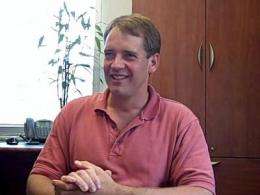Dividing cells 'feel' their way out of warp

Every moment, millions of a body's cells flawlessly divvy up their genes and pinch perfectly in half to form two identical progeny for the replenishment of tissues and organs -- even as they collide, get stuck, and squeeze through infinitesimally small spaces that distort their shapes.
Now Johns Hopkins scientists, working with the simplest of organisms, have discovered the molecular sensor that lets cells not only "feel" changes to their neat shapes, but also to remodel themselves back into ready-to-split symmetry. In a study published September 15 in Current Biology, the researchers show that two force-sensitive proteins accumulate at the sites of cell-shape disturbances and cooperate first to sense the changes and then to resculpt the cells. The proteins — myosin II and cortexillin I — monitor and correct shape changes in order to ensure smooth division.
"What we found is an exquisitely tuned mechanosensory system that keeps the cells shipshape so they can divide properly," says Douglas N. Robinson, Ph.D., an associate professor of Cell Biology, Pharmacology and Molecular Sciences, Johns Hopkins University School of Medicine.
Faulty cell division can put organisms, including people, on the pathway to diseases such as cancer, Robinson notes, and a better understanding of how cells respond to mechanical stress on their shapes could present new targets for both diagnosing and treating such diseases.
Working with hardy, single-celled protozoa that move and divide similarly to human cells, the scientists watched through microscopes while they deformed the cells' shapes with a tiny instrument that, like a soda straw, sucks in on the cell surface and creates distorted shapes.
"This particular method, based on a very old principle that dates back to Archimedes, enables us to deform cells without killing them, much in the same way that natural processes in the body constantly assault them, Robinson says."
Once the cells were warped, the scientists monitored the movements of fluorescent-tagged myosin II and cortexillin I. Myosin, which normally accumulates in the middles of cells during division to help power that process, collected instead at the sites of disturbances made by the micropipette. Also amassing with myosin was cortexillin I, a so-called actin-crosslinking protein that, like glue, holds the toothpick-like filaments of a cell's housing together.
In the experiments, as soon as the two proteins accumulated to a certain level, the cells contracted, escaping the pipettes and assuming their original shapes. After the cells righted themselves, the proteins realigned along the cells' midlines and pinched to divide symmetrically into two daughter cells.
The researchers repeated the experiment using cells engineered to lack myosin II and then again with cells lacking cortexillin I. They discovered that cortexillin I responded to deformations except when myosin II was removed, and myosin II responded to deformations except when cortexillin I was removed.
"It's clear that the two need each other to operate as a cellular mechanosensor," Robinson says.
Source: Johns Hopkins Medical Institutions












